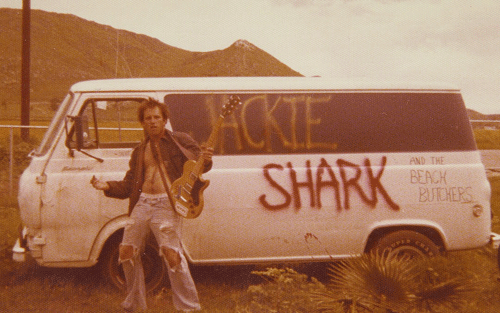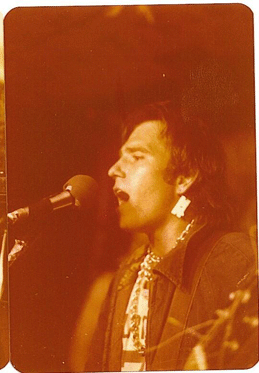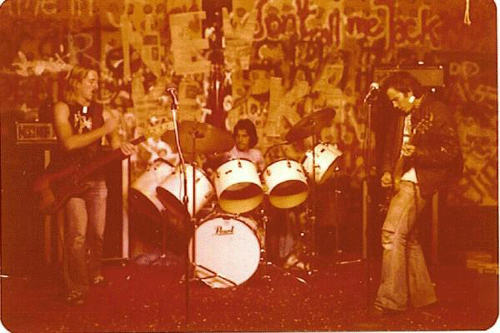And the Beach Butchers

Jackie Shark and the Shark Van in Riverside
The long-lost KBD legend has been found!
JACKIE SHARK AND THE BEACH BUTCHERS:
Killed By Death mystery solved!
Jackie Shark has lived in the city of Riverside since 1956 when his family moved there from Norwalk when he was a baby. By the age of ten, Jackie was learning how to play guitar on a Fender Mustang. This was around 1965. Some of his first influences included the Animals, Seeds, and Yardbirds. During the mid to late 1960’s Jackie attended some of the Swing Auditorium shows in San Bernardino with his older sister, Vickie Oliver, where he saw legendary groups like Jimi Hendrix, Janis Joplin, Iron Butterfly, Canned Heat, and the Animals as a teenager. At some of these shows he also saw local groups like the Good Feelins and Caretakers.
By the mid-1970s, Jackie was playing guitar in local hard rock bands. One of the bands was called Mace and featured another band member, Ken Morse, who would soon join Jackie in the punk ranks. The inspiration to get into punk rock came about in late 1976 when Jackie heard “Anarchy in the U.K.” by the Sex Pistols playing on the radio and rushed to the local record store to buy a copy of the Pistol’s LP. After repeated listens to the Pistol’s LP, Dead Boys’ first LP and tracks by the Ramones and Richard Hell and the Voidoids, Jackie decided to leave the hard rock churnings of Mace and start his own punk band, Rabies, along with Ken Morse, who also jumped ship from Mace. They were joined by a Hispanic drummer named Tony. It was during this transition that Jack was given the punk name Jackie Shark as he used to wear shark skin boots when he played and often acted like a predator toward any girls that hung around him or his bandmates.
Rabies is Riverside’s first true punk band and possibly the first punk band in the Inland Empire of Southern California if we overlook the Low Numbers, from Claremont, which is in Los Angeles County. Either way, Rabies was the first, and only, Inland Empire band to play at Brendan Mullen’s legendary Masque punk club in Hollywood. By January 1978, Rabies already had original songs like: “Rape and Murder”, “Pyromania Kids”, “Second Generation Rising”, “Mary Lou”, “Alley Brats”, and “American Arrogance” along with the typical cover songs of the era by the Sex Pistols, Dead Boys, and Eater. At one point Jackie made a trip to San Francisco and approached Dirk Dirksen with a practice tape recording of the band during a Nuns show at the Mabuhay Gardens. Dirksen told Jackie that they sounded too hard rock and said to ask him again for a show after they practiced some more and had more of a punk sound. Jackie returned to Riverside undaunted by Dirksen’s refusal.
Soon after Jackie got back from San Francisco; Rabies hung out for a few nights at the Masque in Hollywood and approached owner Brendan Mullen about playing. Mullen, in typical nice guy fashion, listened to the band’s demo-cassette (approximately four hours worth of practices on tapes still exist) and agreed to let the band open for Ripper (Gerhard Helmut’s second band after Los Angeles glam band Shady Lady) on Sunday night, January 8, 1978. Brendan thought the band would sound better with the name “Riverside Rabies”, but Jackie and company did not agree so it was just Rabies that took the stage that night. Very few people were on-hand to witness the event (after a two-night stint by the Avengers), but luckily the band took some photos to document the happening.
After the Masque show, Rabies imploded due to musical differences. Jackie wanted to continue, but needed a new name and new band members. A guy named Ron Parvo, from San Bernardino, joined him on bass for a few shows and helped to coin the name of the new group. Jackie remembers, “We actually played somewhere up in Bloomington called ‘Bloomington Beach’, which somebody had wrote on a sign there maybe in the mid-70s and it had stayed there for a while. And it was said that we butchered up every song that we ever attempted to play and I guess…me and Ron were talking and yeah…Jackie Shark…Rabies…just Jackie Shark…and then Jackie Shark and the Beach Butchers. I guess with the night we had it just kind of made sense.” The band only played about two shows using this name before members left and Jackie was alone again.
Jackie thought enough of his songs that he wanted them recorded no matter what so he and a friend, Jeff Tobey a.k.a. Jeffrey Blast, decided to set up a 4-track at Blast’s parent’s house and recorded the two songs. Jackie played guitar, bass, and sang while Jeffrey played drums and worked the echoplex tape delay, MXR Phase 90, and 4-track recorder. They recorded at least two songs to completion, on February 15, 1978. Besides “Mary Lou” and “Second Generation Rising”; Jackie believes that they also recorded “American Arrogance” and “Alley Brats”, but no tapes can be found to substantiate this. As soon as they had their songs on tape, they sent copies of the two completed songs out as demos, possibly to try and get a record deal. One such cassette tape was found in the Bomp! Records archives in 2005.
With no record deal forthcoming, the band quickly decided to just do it themselves. Jackie remembers going to some record store in Compton that advertised a package deal to press records. You gave the store your tape or reel and they had records made for you. Jackie paid his money and soon had his very own record out on his own label, Snotty Nose Records. The name of the record label was inspired by the title of the Dead Boys first LP Young, Loud, and Snotty. Approximately 200-300 copies of the record were pressed during the Spring of 1978. Jackie left some copies on consignment at local record stores, but he says that most copies were given away to friends and family, or given away for promotion.
One person that received two copies for promotion and airplay was DJ Rodney Bigenheimer of KROQ fame. The story goes that Jackie got into a verbal fight with Rodney while at the Masque watching the Avengers the night before Rabies was supposed to play. Jackie thought it was no big deal and when he finally got a record out he sent two copies to Bigenheimer hoping that it would get some radio airplay. He never heard it played and tried calling in and requesting it a few times to no avail. Finally, he went down to the station and asked to speak to Bigenheimer himself. Rodney met him in the lobby holding a copy of the single and told Jackie that he remembered him from the fight they had and told him that he would never play his record on his show and promptly snapped it in half in front of Jackie. Set-backs like this ensured that the record would fail to attract any interest or even the attention of local punks, from whom he hoped to find more band members.
Jackie kept practicing punk guitar until about 1980 when he became a born-again Christian and somewhat turned his back on punk rock and his Jackie Shark persona. Unfortunately for the band, the Riverside punk scene began to explode in late 1979 with groups like Death Patrol, Moral Sex, Test Pattern (pre-White Flag) and others starting up and the opening of the Squeeze club, and shortly after the Ritz club, which opened their doors to punk rock in downtown Riverside. Jackie does not remember any of the punks or anything about the scene past his experiences with his bands.
In the years between 1980 and 2009, Jackie moved on with his life. He married his wife Daveta back around his Rabies days and is still with her today. Over the years, Jackie dealt with problems involving addiction and found comfort through his Christian beliefs. Both he and his wife have recorded gospel and blues music together and raised a family. Jackie labored for a while as a truck driver and today works with building contractors. He did not think much about punk rock during these years, but he fondly kept a copy of his record hanging on his wall as a memento of the fun that he had and as a testament to illustrate his DIY achievement.
Jackie Shark and his 1978 single were total unknowns to the record-collecting punk freaks until about 1997 when Steve Turner, from the band Mudhoney, discovered the second known copy of the record (the first residing in Rodney Bigenheimer’s collection. He apparently snapped one and kept one which he sold during the KBD craze) while on his usual record-collecting journeys. It was his discovery of the disc that created a lot of hype when he decided to sell it for a thousand dollars when he was hard up for money. Knowing that this record actually did exist fanned the flames and caused the record-collecting intelligentsia to go into high-gear on a mission to discover who Jackie Shark was and where the band came from. Collectors worldwide were also paying exorbitant amounts for copies of the single and one copy actually sold for over $1,800 at an auction of rare records. Several other copies sold around the same time for about $1,200 each.
In 2001, a bootleg compilation LP titled No One Left To Blame came out and included the song “Mary Lou” from the Jackie Shark and the Beach Butchers single, but only mentioned that it might be from Southern California. It was not until early 2005 when these suspicions were confirmed. On a raid upon the Bomp! Records warehouse, plundering the mine for treasures, Johan Kugelberg, with Ryan Richardson present, found a demo-cassette amongst departed Greg Shaw’s archive of tapes. This two-song cassette contained both songs from what would become the Jackie Shark and the Beach Butchers single and was labeled with an address that indicated Riverside, California along with the date the music was recorded, February 15, 1978. Phone calls to local Riverside punks ensued. Pat Fear from long-time Riverside area punk band White Flag was called several times and pumped for information along with myself and some others that all lived nearby. None of us had ever heard anything about the band even though most of us had lived in the area for decades.
All punk collectors in Southern California, and elsewhere, were now on the alert and asking about the band at record shows and swap meets. It has often been said that the internet is bringing people together and making our world smaller. This is true in the case of Jackie Shark. During the summer of 2009, a punk collector from Japan was apparently scouring myspace for MP3s and stumbled onto a myspace page that had just been created by Jackie’s son, Jeremy, which featured not only the Christian and blues acoustic guitar work of Jackie and his wife, but also a recording from Jackie’s punk rock past, which was both sides of the legendary single. The collector immediately e-mailed asking if the myspace page owner had any connection to Jackie Shark and received an affirmative reply that Jackie Shark was in fact his father. The collector tried further e-mails, but they were not immediately replied to until after Jeremy and Jackie’s sister, Vickie, did some Google searching to find out how anyone would even know about Jackie Shark, or why they would care.
Shortly thereafter, Jackie and relatives found out about the Killed By Death craze and the detective work done by collectors. Jackie’s nephew decided to contact punk collector extraordinaire, Ryan Richardson. Ryan, who had been searching for any contact to this band for years, immediately offered to purchase any remaining copies of the record that Jackie might have on hand. Luckily, Jackie’s sister, Vickie, remembered that there was a small box of the records that were sitting on a table outside under the eaves of the family house her father had owned. She had hung onto the records all these years and had recently put them outside as she was cleaning the house out after her father’s death. Vickie got the records and a deal was struck with about 50 copies sent to Ryan. Ryan returned about 10 copies that he felt had some defect in them like slight warps. Ryan sold the remaining 40 copies directly to worldwide punk collectors for $395 apiece. These were sold on consignment with most of the proceeds going to Jackie. Ryan sold out of all 40 copies within a week of his posting them for sale.
It was during this time that Ryan had told me in an e-mail that Jackie had decided to put up a website dedicated to his former bands. Artifix Records was able to get in touch and a deal was made to release a reissue of his now-legendary 1978 single. The reissue is now out and available at a fair, non-KBD, price so that everyone can hear it.
 Jackie Shark singing at the Masque, Hollywood
Jackie Shark singing at the Masque, Hollywood
Jackie Shark's first band, Rabies, at the Masque Nov.1977

Picture of 7"